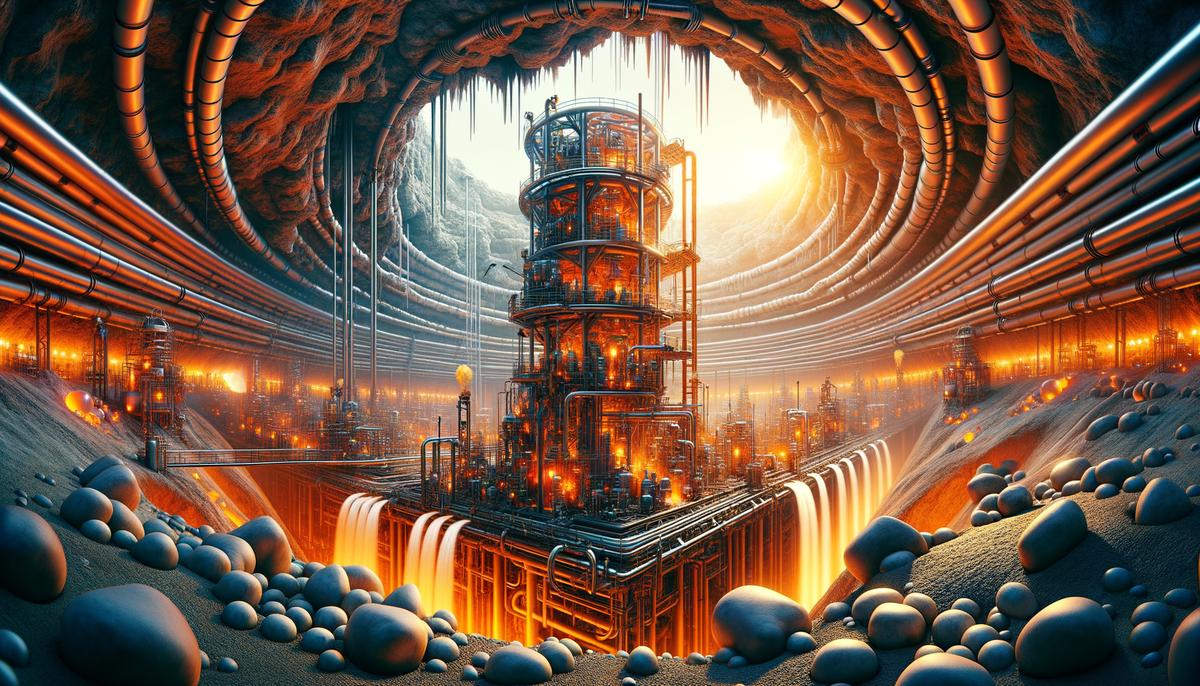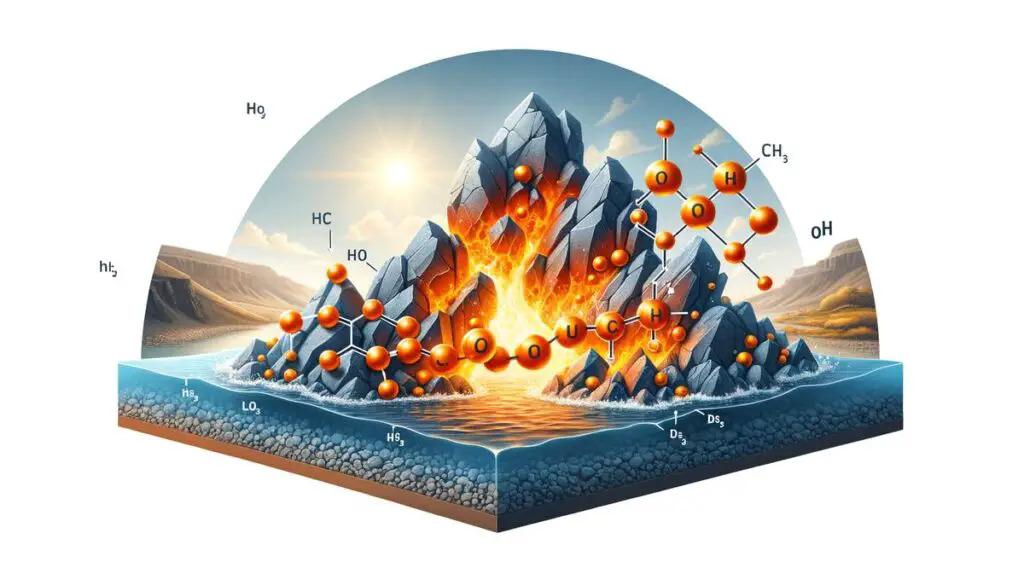The journey into the science of orange hydrogen opens up a narrative that stretches beyond the confines of traditional energy sources, guiding us through a process where chemistry and environmental stewardship converge. This story unfolds beneath our feet, in the hidden geological formations that house the potential for a cleaner, greener future. As we traverse this landscape, we uncover the mechanisms that not only promise to revolutionize our energy systems but also offer a blueprint for mitigating climate change.
The Science Behind Orange Hydrogen
Iron-rich rocks are the unsung heroes in the production of orange hydrogen. When these rocks, abundant in iron minerals, interact with water found naturally underground or deliberately injected, a chemical reaction ensues.
Fact Check
Claim: Orange hydrogen can produce clean energy and sequester CO2 emissions
Description: The process of creating orange hydrogen involves iron-rich rocks reacting with water to produce hydrogen and oxygen. This process also sequesters carbon dioxide, transforming potential greenhouse gas emissions into harmless rocks. This suggests a potential pathway to economic and environmental efficiency.
At the molecular level, the iron minerals catalyze the splitting of water molecules (H2O) into hydrogen gas (H2) and oxygen. The reaction also produces iron oxides—compounds of iron and oxygen—which display a distinctive orange hue, giving orange hydrogen its name and leaving behind vibrant, rust-colored mineral deposits.
This process doubles as a green champion. The geological formations that generate hydrogen also serve as secret chambers for trapping carbon dioxide (CO2). When CO2-laden water is introduced into these formations, it reacts with the minerals to form solid carbonates, effectively sequestering the CO2. This side reaction transforms potential greenhouse gas emissions into harmless rocks, delivering a one-two punch against global warming.
Picture geothermal power technologies, where water is injected deep underground and returns with beneficial output. For orange hydrogen, CO2-enriched water is pumped into the depths of the earth, encountering iron-rich rocks ready to perform their task. During the chemical exchange, the water surrenders its CO2 load, replacing it with hydrogen. This hydrogen-rich water is then brought back to the surface through extraction wells, prepared for harvesting.
In essence, these hidden factories powered by nature itself churn out hydrogen and recycle CO2 through an elemental dance orchestrated by ancient rocks and water. Each cycle takes a step towards reimagining our energy sources, transforming them from problem to solution.

Environmental Impacts and Benefits
Orange hydrogen embodies human ingenuity, shifting our focus from the sky to the soil as a treasure trove for energy generation. This subsurface journey aims not only at energy production but also encapsulates a profound stride towards environmental redemption. The clandestine chemistry between iron-rich rocks and water serves a dual purpose, yielding clean energy while participating in a grander scheme of mitigating climate change.
Trapping CO2 in solid carbonates showcases a method to combat greenhouse gas accumulation by turning a potent problem into a permanent solution—literally set in stone. This endeavor represents an elegant synergy of natural geological processes and human technological innovation, crafting a narrative where reducing our carbon footprint is innately integrated into the process of generating energy.
Each molecule of hydrogen produced is a step away from fossil fuels, a lesser dependency on carbon-emitting energy sources. With orange hydrogen, we glimpse an era where our energy consumption pays forward—not by taxing our environment further but by healing it. This transition to orange hydrogen revamps our relationship with the planet, moving us from consumers to caretakers, participants in a cyclical exchange that sustains both our energy needs and the environmental equilibrium.
Orange hydrogen's role in environmental rehabilitation is further accented by its ability to integrate seamlessly into the broader ecosystem of renewable energy sources. This process underscores the potential to replace and complement existing renewable energy infrastructure, presenting a harmonious blend of solutions that form a resilient, diversified energy portfolio. Such integration caters to the fluctuating nature of our energy needs, ensuring that the pursuit of sustainability does not compromise reliability or efficiency.
With every molecule of hydrogen extracted and every ton of CO2 securely sequestered, we edge closer to a cleaner, greener future—a testament to the possible harmony between human progress and nature's grandeur. Orange hydrogen embodies a spirited response to the climate crisis, offering a beacon of hope against the challenge of global warming.
The pursuit of orange hydrogen opens avenues for groundbreaking research and development in green technologies, propelling us towards innovative solutions that harness the untouched potential lying beneath us. It's a call to arms for scientists, engineers, and visionaries to explore, experiment, and expand our horizons, empowered by the promise that lies in the heart of our planet.

Technological Challenges and Solutions
Maneuvering the path from theory to large-scale application presents a significant hurdle in mimicking this natural process at a volume necessary to substantially impact our energy systems. It's akin to transforming a boutique workshop into a massive factory that operates around the clock, ensuring every component, from injection wells to deep-earth chemical reactions, functions with efficiency and reliability.
The design and construction of injection and extraction wells represent a critical piece of the puzzle. These wells must withstand the extreme pressures and temperatures found deep underground, ensuring safe and effective delivery of water to the rock formations and back to the surface, laden with hydrogen. It's like designing a straw that reaches the bottom of an exceptionally deep and hot coffee cup, ensuring the coffee—in this case, hydrogen—is perfectly brewed every time.
The chemical ballet that needs to happen underground is another challenge. While nature has been playing this tune for eons, asking it to perform on demand requires a conductor who understands the subtleties of pressure, temperature, and mineral composition. Getting the conditions just right to coax out hydrogen while locking away CO2 efficiently pushes the bounds of our current chemical engineering expertise. Each reaction must be meticulously choreographed, balancing speed with sustainability—an industrial symphony played out in the depths of the earth.
Advanced computational models enter the fray, wielding algorithms to map out the intricate network of potential reactions. These digital simulations are our crystal balls, revealing how water and CO2 mingle with the subsurface geological formations to produce hydrogen. Optimizing this scenario involves crunching vast quantities of data to forecast how changes in variables might affect the outcome. It's like playing chess against a computer that's always ten steps ahead, requiring ingenuity and innovation at every turn.
Collaboration becomes the cornerstone for overcoming these technical obstacles. Mining expertise from geology, hydrology, chemical engineering, and computer science—each field brings a piece of the puzzle to the table. Imagine a roundtable where each participant speaks a different language, yet all strive to compose a unified solution that sings harmoniously. The goal is to construct a fully optimized system that can upscale orange hydrogen production from niche to normal.
Such endeavors mark not just engineering triumphs but leaps towards an environmentally benign energy landscape. Every inch gained in efficiency, every barrel of CO2 sequestered, contributes to a larger victory—turning back the tide of climatic change and spearheading a revolution toward splintering dependence on fossil fuels. In a world thirsting for sustainable energy solutions, the quest for scalable orange hydrogen production encapsulates the blend of audacity and ingenuity necessary to quench it.

Comparison with Other Hydrogen Colors
Orange hydrogen emerges within the broader spectrum of hydrogen production methods—grey, blue, and green hydrogen. Each color represents a different production process, environmental impact, and stage of technological advancement, contributing unique shades to the energy mosaic of tomorrow.
Grey hydrogen, the veteran of hydrogen production, is predominantly manufactured through steam methane reforming (SMR). The process involves natural gas and results in significant CO2 emissions, contrasting the clean energy goals of today. While its established infrastructure and low production costs present an economical advantage, the environmental ledger tells a different story—one marked by a carbon footprint unable to tiptoe around climate change concerns.
Blue hydrogen introduces a middle pathway. By integrating Carbon Capture and Storage (CCS) technology into the process of creating hydrogen from natural gas, blue hydrogen offers a reduced emission alternative. While it steps closer to aligning with sustainable energy mandates, the carbon capture mechanism isn't flawless. Gaps in efficiency leave room for greenhouse gases to escape, placing a question mark on its long-term environmental viability.
Green hydrogen, the emblem of ecological harmony within the hydrogen family, is produced via electrolysis powered by renewable energy sources such as solar or wind. It splits water into hydrogen and oxygen without emitting CO2. While it paints an idyllic picture of clean energy production, the current high costs associated with renewable energy and inefficiencies in electrolysis position it as a premium alternative. Despite its impeccable environmental credentials, economic accessibility remains its hurdle to widespread adoption.
Amidst this spectrum sits orange hydrogen, carving its unique niche. What differentiates orange hydrogen is its dual potential to not only produce clean energy but also tackle the issue of CO2 emissions head-on. By marrying the process of hydrogen production with CO2 sequestration, orange hydrogen goes beyond mere emission reduction; it seeks to reverse the damage. Its reliance on abundant iron-rich rock formations tilts the scale in favor of low operational costs and suggests a potential pathway to economic as well as environmental efficiency.
The production scale and technological maturity of orange hydrogen are presently in their nascent stages compared to its counterparts. However, the promise it holds is unparalleled—offering a glimmer of hope for not just meeting but exceeding net-zero ambitions. As technological hurdles are incrementally surmounted, orange hydrogen stands poised to not only join but potentially transcend the environmental benefits provided by blue and green hydrogen.

Future Prospects and Potential
As the development of orange hydrogen forges ahead, its potential within the global energy mix begins to crystallize. The journey from laboratory curiosities to field-scale implementation is tethered to advancements in technology and infrastructure. However, overlaying this technical voyage is a narrative far richer, involving policy formulation, market adaptation, and societal acceptance.
Policy and market dynamics wield substantial influence over the trajectory of orange hydrogen. Governments worldwide stand at the helm, steering through incentives for research and development, subsidies for green technologies, and stringent regulations against carbon emissions.1 Imagine a landscape where policy not only encourages but emboldens entrepreneurial ventures into orange hydrogen, knitting a robust support system that transcends the traditional barriers of entry and investment apprehension.
Market dynamics play a paramount role in embracing orange hydrogen—price points, consumer demand, and competition set the pace. In its nascent stage, adopting orange hydrogen might appear as stepping into uncharted waters for many industrial players. However, as the scales of production escalate and technological efficiencies are realized, cost-competitiveness becomes a tangible milestone.2 It's akin to catching wind in our sails, propelling the commercial acceptance of orange hydrogen across industries varying from transportation to power generation.
The synchronization of orange hydrogen with current and future infrastructures hints at an adaptable energy model. What once relayed oil or natural gas can be repurposed or co-opted to transport hydrogen. Envision a revamped energy infrastructure that accommodates a smooth flow of hydrogen, integrating seamlessly with existing pipelines and distribution networks.3 This adaptive reuse not only curtails the need for hefty investments but also fast-tracks the timeline to widespread adoption.
Addressing integration challenges plants us squarely in front of the techno-socio-economic triangle. Not only does the technological scalability of production warrant attention but integrating orange hydrogen into the vast tapestry of renewable energy sources implies a delicate balancing act. It necessitates a concert of renewable energies, each with its crescendos and decrescendos, harmonizing to deliver a resilient and sustainable energy mix.
Capturing the quintessence of what orange hydrogen presents entails peering into a future where clean energy coexists with economic prosperity and environmental stewardship. The symbiotic relationship envisioned between humankind and the geological bounty beneath us outlines a roadmap toward carbon neutrality.
As the narrative of orange hydrogen unfolds, what emerges is not merely an alternative energy source but a holistic blueprint for ecological restoration, technological renaissance, and societal shift toward sustainability. The layers of scientific intrigue are laced with a deeper calling—to reimagine our interplay with natural resources in a manner that honors and safeguards our planet for generations yet to come.

In conclusion, the essence of orange hydrogen transcends its role as an alternative energy source, embodying a comprehensive approach to ecological restoration and technological innovation. At its core, this narrative champions a harmonious relationship between humanity and the planet’s natural resources. By harnessing the transformative power of orange hydrogen, we stand on the precipice of a sustainable future, where energy production aligns with our environmental aspirations, marking a pivotal stride towards carbon neutrality.
- International Energy Agency. The Future of Hydrogen. Paris: IEA Publications; 2019.
- Hydrogen Council. Path to Hydrogen Competitiveness: A Cost Perspective. Brussels: Hydrogen Council; 2020.
- Melaina MW, Antonia O, Penev M. Blending Hydrogen into Natural Gas Pipeline Networks: A Review of Key Issues. Golden, CO: National Renewable Energy Laboratory; 2013.

